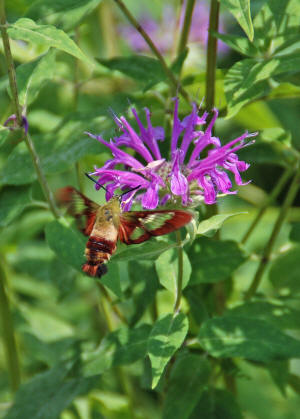|
 Create,
Plant, and Maintain a Pollinator Garden Create,
Plant, and Maintain a Pollinator Garden
By Melinda Myers
[June 14, 2025]
Celebrate National Pollinator Month this June by
creating and maintaining a garden that attracts and supports these
important members of our ecosystem. Pollinators are responsible for
about 75% of the food we eat and play an important role in producing
food, fiber, medicine and more. The European honeybee is the most
well-known but our native bees along with moths, wasps, beetles,
flies, bats, and some birds also help pollinate our gardens.
Just like the honeybees and Monarch butterflies, many
pollinators are struggling with their populations dwindling due to
pesticides and loss of habitat.
|
|
You can make a difference by creating pollinator
gardens filled with their favorite plants.
Start helping all pollinators and the environment by reducing or
better yet eliminating the use of pesticides. If you opt for a
chemical solution, look for the most eco-friendly product and as
always read and follow label directions to minimize the negative
impact on the environment and pollinators.
As you create your pollinators’ paradise include shelter from
predators and the weather. Include trees and shrubs, if space
allows, providing you with year-round interest and nectar, pollen,
and tasty leaves as well as nesting sites and safe havens for the
various life stages. Leave patches of open soil for ground nesting
bees and some leaf litter to shelter some butterflies, bumblebees,
and other pollinating insects.
Plant a variety of native plants, herbs and other pollinator
favorites that provide nectar and pollen throughout the season.
Spring bulbs, early blooming wildflowers and perennials provide
essential food that is often in limited supply early in the season.
Fall flowering plants provide needed energy supplies as the bees,
hummingbirds, and other pollinators prepare for winter.
Include plants with different colors and shaped flowers to attract
and support a variety of pollinators. Plant flowers in mass. You
will enjoy the display, the garden will require less maintenance,
and the pollinators will use less energy when they can gather lots
of food from a smaller area.
Plant masses of flowers like columbine, sweet alyssum, annual and
perennial salvia, cupheas, cosmos, phlox, zinnias, bee balm, liatris,
sedum, asters and more to help attract these beauties to your
landscape. Fuchsias, begonias and impatiens are perfect for shady
locations. And don’t let a lack of space dissuade you; even a window
box of flowers can help.
Bigger flowers are not always better. Double flowers
may be showy, but they have less nectar and pollen. The multiple
layers of petals may hinder access to the nectar and pollen they
contain.

[to top of second column] |

Grow some herbs in the garden and containers for you,
the bees, and other beneficial insects. Let some go to flower and
watch for visitors on thyme, borage, oregano, and other herb
flowers. Tolerate a bit of damage on parsley, dill and fennel as the
swallowtail caterpillars dine on the leaves. These vigorous plants
will recover once the caterpillars transform into beautiful
butterflies.
Add some native plants to your gardens whenever possible. They are a
richer source of nectar and pollen than cultivated plants.
Pollinators and other beneficial insects have evolved with these
plants, providing a mutual benefit.
Puddles, fountains, birdbaths and even a damp sponge can provide
needed water. Include water features with sloping sides or add a few
stones for the visitors to sip without getting wet. Sink a shallow
container of sand in the ground. Keep it damp and add a pinch of sea
salt for the butterflies and bees. Add a flat stone for warming and
be sure to watch for and snap a few photos of visitors as they sip
and sun in your garden.
If you create it, they will come. Be patient, make note of their
favorites, and keep growing to attract, support and enjoy these
important garden visitors.
Melinda Myers has written more than 20 gardening books,
including the Midwest Gardener’s Handbook, 2nd Edition and Small
Space Gardening. She hosts The Great Courses “How to Grow Anything”
instant video and DVD series and the nationally syndicated Melinda’s
Garden Moment TV & radio program. Myers is a columnist and
contributing editor for Birds & Blooms magazine and was commissioned
by Summit for her expertise to write this article. Myers’ website is www.MelindaMyers.com.
[Photo courtesy of MelindaMyers.com] |